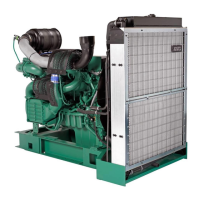Do you have a question about the Volvo Penta TWD1643GE and is the answer not in the manual?
Recommends appropriate safety equipment to reduce injury risk during operation and maintenance.
Highlights fire and explosion risks associated with fuels and batteries, advising good ventilation.
Instructs to immobilize the engine by turning off the power and placing a warning notice.
Stresses the importance of operating the engine in well-ventilated areas to avoid hazardous gases.
Warns about the safety risks of approaching running engines and hot components.
Provides pre-start checks including fuel/gas leaks, air filter, and valve cover.
Details safety measures for electrical system work, including stopping the engine and disconnecting power.
Highlights fire and explosion risks during refueling and mandates engine stoppage.
Warns about high fuel pressure risks and advises wearing safety goggles during leak detection.
Warns about fire and explosion risks from batteries and advises against sparks or open flames.
Details the procedure for running in the engine during the first 10 operating hours.
Highlights the importance of regular servicing and genuine Volvo Penta parts for reliability.
Explains the electronic system for diesel engine control, including fuel regulation and diagnostics.
Introduction to the DCU, its functions like engine control, monitoring, diagnostics, and parameter setting.
Details the procedure for starting the engine, including pre-heating time and starter motor cranking.
Outlines essential checks before starting the engine, such as oil level, fuel valves, and leaks.
Provides preparations for engine starting in extreme cold conditions, including fuel and oil selection.
Recommends running the engine at high idle before shutdown to equalize temperature and cool the turbo.
Provides procedures for stopping the engine by engaging the clutch and pressing the STOP button.
Explains the diagnostic function's purpose: monitoring, control, protection, and environmental impact.
Describes how faults are displayed on the DCU and the steps to get fault information.
Explains fault detection and display on the DCU II, including fault codes and remedies.
Details how faults are shown on the DU display, including alarm/warning messages and buzzer sounds.
Provides a table of symptoms and possible causes for engine malfunctions.
Lists fault codes (SPN, PID, FMI) and their corresponding components and fault indicators.
Provides step-by-step instructions for changing the drive belt on the engine.
Provides technical specifications for various Volvo Penta engine models.
Recommends appropriate safety equipment to reduce injury risk during operation and maintenance.
Highlights fire and explosion risks associated with fuels and batteries, advising good ventilation.
Instructs to immobilize the engine by turning off the power and placing a warning notice.
Stresses the importance of operating the engine in well-ventilated areas to avoid hazardous gases.
Warns about the safety risks of approaching running engines and hot components.
Provides pre-start checks including fuel/gas leaks, air filter, and valve cover.
Details safety measures for electrical system work, including stopping the engine and disconnecting power.
Highlights fire and explosion risks during refueling and mandates engine stoppage.
Warns about high fuel pressure risks and advises wearing safety goggles during leak detection.
Warns about fire and explosion risks from batteries and advises against sparks or open flames.
Details the procedure for running in the engine during the first 10 operating hours.
Highlights the importance of regular servicing and genuine Volvo Penta parts for reliability.
Explains the electronic system for diesel engine control, including fuel regulation and diagnostics.
Introduction to the DCU, its functions like engine control, monitoring, diagnostics, and parameter setting.
Details the procedure for starting the engine, including pre-heating time and starter motor cranking.
Outlines essential checks before starting the engine, such as oil level, fuel valves, and leaks.
Provides preparations for engine starting in extreme cold conditions, including fuel and oil selection.
Recommends running the engine at high idle before shutdown to equalize temperature and cool the turbo.
Provides procedures for stopping the engine by engaging the clutch and pressing the STOP button.
Explains the diagnostic function's purpose: monitoring, control, protection, and environmental impact.
Describes how faults are displayed on the DCU and the steps to get fault information.
Explains fault detection and display on the DCU II, including fault codes and remedies.
Details how faults are shown on the DU display, including alarm/warning messages and buzzer sounds.
Provides a table of symptoms and possible causes for engine malfunctions.
Lists fault codes (SPN, PID, FMI) and their corresponding components and fault indicators.
Provides step-by-step instructions for changing the drive belt on the engine.
Provides technical specifications for various Volvo Penta engine models.
| Engine Model | TWD1643GE |
|---|---|
| Engine Type | Diesel |
| Compression Ratio | 17.5:1 |
| Fuel System | Common Rail |
| Lubrication System | Wet sump |
| Configuration | Inline 6 |
| Bore | 144 mm |
| Stroke | 165 mm |
| Aspiration | Turbocharged |
| Cooling System | Freshwater cooled |
| Rotation | Counterclockwise |
| Emissions Compliance | EPA Tier 3 |











